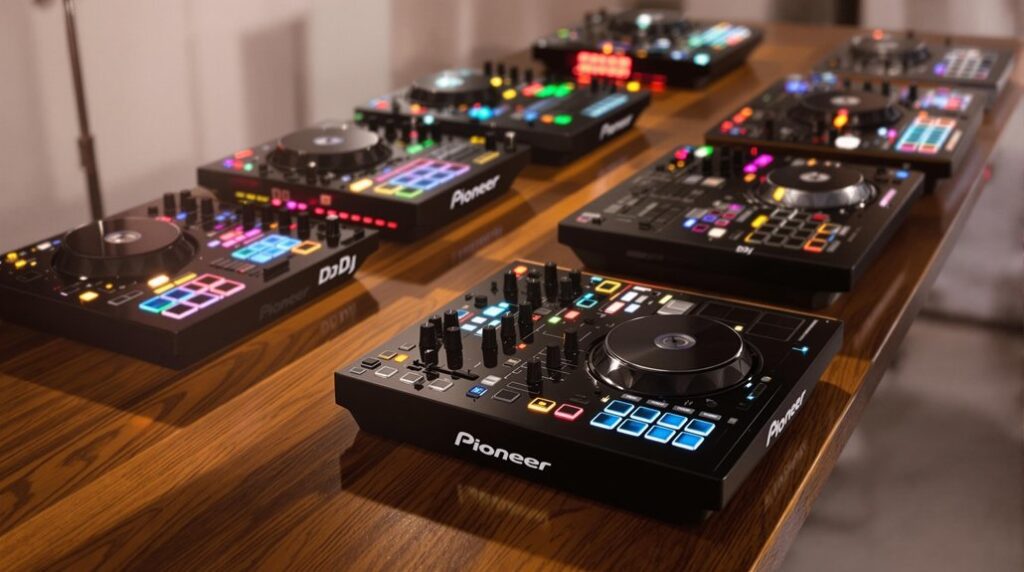Mastering harmonic mixing requires understanding the relationship between a track's key and BPM. Key defines the musical scale and BPM dictates tempo. Together, they enable smooth changes by maintaining melodic alignment and energy consistency. Key detection software and the Camelot Wheel assist in selecting compatible tracks. Techniques like energy level balancing and phrase alignment enhance the flow of a DJ set, helping preserve sound quality. Exploring these tools and techniques will raise the audience's listening experience.
Key Takeaways
- Use key detection software like Mixed In Key for precise harmonic mixing.
- Apply the Camelot Wheel to identify compatible keys for smooth transitions.
- Match tracks within a 2-3 BPM range to maintain energy consistency.
- Categorize tracks by energy level to guide mood shifts during sets.
- Avoid drastic tempo changes to prevent distortion and preserve sound quality.
Understanding the Relationship Between Key and BPM
When delving into the intricacies of harmonic mixing, understanding the relationship between key and BPM is vital. The key of a track defines its musical scale, while BPM dictates its tempo, both important for creating seamless, melodic shifts. Mixing in key enhances track compatibility, ensuring that melodic elements align harmoniously. Maintaining energy consistency requires tracks to have a similar BPM, ideally within a 2-3 BPM range. The Camelot Wheel serves as a visual tool, aiding DJs in identifying compatible tracks for smooth shifts. Alterations beyond ±6-7 BPM can shift pitch by a semitone, risking discordant clashes. Utilizing harmonic mixing techniques allows DJs to ensure smoother shifts between tracks, enhancing the overall listening experience. Key detection software assists in efficiently pinpointing compatible tracks, streamlining harmonic mixing and allowing DJs to craft fluid, engaging sets.
The Role of Key Detection Software
The intricate dance between key and BPM sets the stage for the pivotal role of key detection software in harmonic mixing.
Professional DJs rely on these advanced tools to navigate the complex world of harmonic mixing techniques. By scanning music collections, key detection software accurately identifies key signatures, empowering DJs to select tracks that mix harmonically and maintain ideal energy levels.
The Camelot Easymix System simplifies this process, bridging the gap for those lacking extensive music theory knowledge. While many DJ software platforms feature built-in algorithms, top professionals prefer specialized software like Mixed In Key for its precision and intuitive interface. This software streamlines library organization, allowing DJs to swiftly curate playlists and execute seamless shifts, elevating their performances to a professional standard.
Additionally, advanced key detection available in some DJ software like Engine DJ enhances the ability to create harmonically matched mixes, ensuring smoother transitions and a more cohesive set overall.
Exploring the Circle of Fifths and Camelot Wheel
Revealing the art of harmonic mixing requires a solid understanding of the Circle of Fifths and its DJ-friendly counterpart, the Camelot Wheel. The Circle of Fifths visually illustrates the relationship between musical keys, aiding DJs in identifying compatible keys for harmonic mixing. The Camelot system simplifies this concept with an alphanumeric approach, arranging Major keys in the outer ring and Minor keys in the inner ring. DJs achieve smooth shifts by moving between adjacent keys, maintaining harmonic flow and adjusting energy levels to enhance the set. By mastering tempo control, DJs can maintain consistent energy on the dance floor, allowing them to focus on creative aspects of mixing.
| Camelot Key | Musical Key |
|---|---|
| 5B | E Major |
| 5A | C# Minor |
| 6B | B Major |
This system empowers DJs to craft dynamic experiences, strategically planning sets and avoiding dissonance for seamless musical journeys.
Techniques for Achieving Seamless Transitions
For DJs aiming to achieve seamless shifts, utilizing key detection software such as Mixed In Key is essential for identifying harmonically compatible tracks quickly and accurately. Shift planning techniques, including the strategic use of the Camelot Wheel, enable DJs to execute smooth key changes and maintain energy levels, ensuring an engaging auditory experience. Harmonic mixing involves understanding 24 musical keys and using them to create emotional impact, enhancing the overall flow and resonance of your set.
Key Detection Software
Revealing the potential of harmonic mixing, key detection software stands as an essential tool for DJs aiming to achieve seamless changes.
Key detection software, such as Mixed In Key and DJ.Studio, automates the process of identifying track keys, especially benefiting those with limited music theory knowledge.
Utilizing the Camelot Easymix System, these programs simplify the art of mixing tracks by highlighting harmonious key relationships, thereby preserving energy flow and enabling smooth shifts.
Over a decade of refinement guarantees high accuracy, making these tools favorable over standard DJ software's built-in options.
The Camelot Wheel, a visual representation, aids DJs in maneuvering compatible tracks, enhancing creativity without sacrificing harmonic integrity.
Consequently, DJs can focus on an energy boost within their sets, elevating performance quality.
Transition Planning Techniques
Steering the intricate art of shift planning, DJs harness a blend of creativity and technical prowess to achieve seamless changes. Utilizing the Camelot Wheel is pivotal for identifying harmonic keys, allowing tracks to blend naturally. Categorizing tracks by energy levels strategically guides when to raise or calm the set's mood. Advanced DJ software, like DJ.Studio, automates key and BPM matching, streamlining the change process. The use of EQ and effects sculpts sound, facilitating a cohesive mixing experience. Precision in timing changes by aligning phrases and beats guarantees a seamless harmonic flow, maintaining audience engagement.
| Technique | Purpose |
|---|---|
| Camelot Wheel | Identify harmonic key compatibility |
| Energy Categorization | Guide mood changes |
| Automix Features | Automate key/BPM matching |
This approach guarantees each change maintains the set's energy and interest.
Balancing Energy and Clarity in DJ Sets
Balancing energy and clarity in DJ sets is a nuanced art that requires a keen understanding of both musical theory and audience dynamics. Selecting music involves aligning BPMs to guarantee tracks fit together seamlessly.
Using the Camelot Wheel, DJs can achieve harmonic mixing while considering energy levels, vital for dynamic DJ sets. Sound quality is preserved by maintaining BPM differences within 2-3, avoiding distortion in electronic genres.
An energy level rating system like Mixed In Key enhances the flow, guaranteeing the dance floor remains animated. Good DJ mixes require smooth transitions, crowd reading, and varied tempos.
- BPM Compatibility: Maintain a 2-3 BPM difference for smooth shifts.
- Harmonic Mixing: Use Camelot Wheel for seamless key changes.
- Energy Levels: Utilize systems like Mixed In Key for dynamic set flow.
- Sound Quality: Prevent audio degradation by avoiding drastic BPM shifts.
Avoiding Pitch Alterations During Tempo Changes
In the intricate art of DJing, maintaining energy and clarity in a set is only part of the equation; understanding the impact of tempo changes on pitch is equally essential.
Altering a track's tempo can inadvertently shift its pitch, distorting the sound with unnatural vocal tones, especially in electronic dance music. The Master Tempo, or Key Lock, feature allows DJs to adjust tempo while preserving pitch, but it may degrade sound quality.
To maintain a consistent tempo throughout a set, DJs must synchronize BPMs to ensure smooth transitions, which enhances the dance floor energy and keeps the audience engaged.
To guarantee seamless mixes, DJs should aim for tracks within a 2-3 BPM difference, avoiding the noticeable pitch shifts found when mixing tracks with BPM differences exceeding ±6-7 BPM.
This approach sustains sound integrity, enabling effective key mixing without compromising the clarity of complex electronic elements.
Enhancing the Flow of a DJ Set
Harmonic mixing serves as a critical technique in enhancing the flow of a DJ set by ensuring musical key compatibility, which prevents jarring shifts and maintains auditory coherence. Utilizing the Camelot Wheel, DJs can strategically navigate energy level shifts, allowing for intentional mood changes that captivate audiences. Understanding harmonic mixing improves DJ sets by ensuring smooth key transitions, which enhances the overall musical experience.
Musical Key Compatibility
Musical key compatibility serves as the cornerstone for creating seamless DJ sets, transforming the listening experience by ensuring smooth shifts and avoiding dissonance.
Utilizing the Camelot Wheel, DJs can identify relationships between musical keys, enabling them to harmonically mix tracks within compatible keys. This technique enhances a set's flow and boosts energy levels, offering a coherent musical journey.
Key detection software like Mixed In Key simplifies the process, categorizing tracks for easy access during performances.
- Major keys often provide an uplifting energy, adding vibrancy to a DJ set.
- Minor keys introduce a deeper, more emotional tone, enhancing mood dynamics.
- Mixing adjacent keys (e.g., 5A to 4A) maintains harmonic consistency.
- Strategic key changes can greatly impact the audience's engagement and enjoyment.
Energy Level Transitions
Energy level shifts are pivotal in crafting an engaging DJ set that maintains audience engagement from start to finish.
Utilizing the DJing technique of energy level shifts involves categorizing tracks on a scale from 1 to 10, allowing seamless selection of music that aligns with the desired energy flow.
The energy mixing table, designed for harmonic mixing, aids in maintaining a consistent mood by guiding the DJ in choosing tracks that match or enhance the set's energy.
Harnessing the Camelot Wheel, DJs identify compatible music keys, facilitating smooth shifts and dynamic changes.
By selecting tracks with similar energy levels, disruption is minimized, creating hands-in-the-air moments.
This structured approach not only enhances performance quality but also opens up creative possibilities for live DJing.
Seamless Track Integration
Building upon the concept of energy level shifts, seamless track integration is a cornerstone of maintaining the momentum and coherence of a DJ set.
Harmonic mixing is essential, guaranteeing tracks are in compatible keys, thereby avoiding dissonance. Utilizing the Camelot Wheel, DJs can navigate key changes smoothly, creating dynamic energy shifts.
Key detection software like Mixed In Key simplifies identifying track keys, streamlining the selection process for harmonically compatible tracks. Maintaining a BPM difference of no more than 2-3 beats per minute preserves energy flow and clarity.
Integrating energy levels into track selection enhances audience engagement and resonates on the dance floor.
- Harmonic mixing prevents dissonance.
- Camelot Wheel aids in key changes.
- Key detection software identifies harmonically compatible tracks.
- BPM management guarantees energy coherence.
Preserving Sound Quality in Harmonic Mixing
Preservation of auditory fidelity is vital in the nuanced art of harmonic mixing, where the integrity of sound quality defines the listener's experience. DJs adept in this field understand that maintaining similar BPMs when mixing tracks is essential. A recommended variance of only 2-3 BPM guarantees minimal sound degradation, safeguarding clarity and the essence of key signatures. In electronic dance music, where tempo adjustments are frequent, drastic changes can lead to undesirable pitch shifts, resulting in fuzzy bass and unclear mids/highs due to digital processing limitations. While features like Key Lock or Master Tempo can help preserve original pitches, they may themselves introduce sound quality issues. As a result, DJs must prioritize compatible BPMs and keys to maintain the harmonious integrity of their mixes. Utilizing tools like the Camelot Wheel aids in identifying compatible tracks, ensuring smooth transitions and preserving the emotional impact of the set.
Elevating the Audience's Listening Experience
Harmonic mixing serves as a pivotal tool in elevating the audience's listening experience by guaranteeing seamless shifts that are melodically coherent.
By utilizing the Camelot Wheel, DJs can skillfully mix in key, maintaining a smooth flow that enhances the set's continuity. This technique prevents dissonant clashes, promoting seamless blends and creating extended mash-ups that resonate with listeners.
Managing energy levels is vital, as it allows DJs to evoke specific moods and foster a deeper emotional connection with the audience. Additionally, harmonic mixing enables exploration across diverse musical genres, attracting a varied audience while maintaining a coherent sound.
Mastering song structure allows DJs to predict and manipulate energy levels, further enhancing the harmonic mixing process and creating a captivating performance.
- Guarantees melodically compatible shifts
- Utilizes the Camelot Wheel to manage energy
- Facilitates extended mash-ups for memorable moments
- Broadens genre exploration attracting diverse audiences
Frequently Asked Questions
Is It Better to Mix in Key or BPM?
A balanced approach to harmonic mixing and tempo matching optimizes musical compatibility in DJ techniques. Careful track selection enhances sound progression, energy levels, and creative shifts, ensuring seamless integration of melodies while maintaining rhythmic consistency for an engaging listening experience.
What Key Is 12A?
The key labeled 12A is D# minor. This key's musical intervals and harmonic relationships, defined by its key signature, offer DJs melodic compatibility through mixing software, utilizing audio harmonics and sound frequencies for creative, seamless shifts.
Does Mixed in Key Detect BPM?
Mixed In Key offers superior BPM detection accuracy, essential for harmonic mixing and tempo matching in DJ software. Its advanced beat analysis outperforms competitors, supporting seamless changes in music production and enhancing DJs' creative expression with precise software comparison insights.
What Does 9B Camelot Mean?
In the Camelot scale, "9B" signifies D# major, essential for harmonic mixing. DJs utilize this key signature in mixing techniques via DJ software, alongside BPM analysis, to guarantee seamless shifts, enhancing sets without extensive musical theory knowledge.
Conclusion
In mastering harmonic mixing, DJs intertwine technical skill with creative artistry. Key detection software and tools like the Circle of Fifths and Camelot Wheel guide them in crafting seamless shifts. By balancing energy and clarity, they preserve sound quality, enhancing the flow and elevating the audience's experience. Avoiding pitch alterations during tempo changes guarantees musical integrity, while a deep understanding of key and BPM relationships enables DJs to deliver sets that resonate with both precision and emotion.




